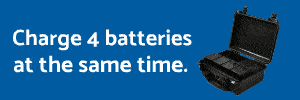Hi Bud,
Thanks for the in-depth response! We really need more in depth responses along with associated material to study for the purpose of trying to better understand how it works.
In my opinion, the better we understand how it works, the better our chances are of knowing when to fly and when not to fly.
Most of what you have posted makes perfect sense but some of it needs more research on my part, especially the relationship between acceleration and motor command.
In your first example where the prop broke (or came off) in flight makes sense to me. The corner of the aircraft that the prop was on would drop causing the IMU to command the FC to increase the voltage to that motor and thereby increase the rpms to raise that corner (or at least attempt to).
There is a direct relationship between voltage and current. Higher voltage results in lower current (and visa versa).
Just for clarification, a motor rated a 10 amps running at idle will likely only draw 3 amps or so but the voltage will be the same. You can load the motor all the way up to it's rated current and still have the same voltage, start going over that rated current by overloading that motor and the voltage will drop proportionally with the current and begin to overheat.
The Inspire motors are 3 phase AC motors, the ESC inverts DC to AC which is why there are 3 wires from the ESC to the motor but only 2 wires from the battery to the ESC (not counting the PWM control wire).
Since they are AC (alternating current) motors, I can give an example with a standard industrial 3 phase motor. Many modern industrial motors are brushless inrunners that can be controlled with a variable frequency drive (VFD) to obtain very low speeds and still retain high levels of torque. In the case of a VFD speed controller, the voltage is the same throughout the entire range of speeds from 1 Hz to 60 Hz, it simply reduces the number of pulses per second. The fact that the voltage is still the same at any speed is what allows it to retain the torque.
If you run an AC motor on 240 volts that's rated for say 10 amps, you can increase the voltage to 480 volts if the motor is rated for it (dual input voltage) and the current will drop proportionally to 5 amps or exactly half the amps at exactly twice the voltage.
That explains why the current was lower at the same point where the voltage was higher.
Another way to look at it is that when the prop broke or came off, the current suddenly dropped and caused the voltage to rise at the same time but only since the command signal increased at the same time.
Rather than voltage and current leveling off with each other, the voltage went high in an attempt to raise that corner where the prop broke since the command signal increased (I'm just trying to say the same thing in different ways here).
This also suggests that the motor speed is calculated by the amount of voltage "And" current that the FC reads.
BTW, I would have to completely agree with your analysis of what happened in this one.
Note: I'm sure you already know all about the relationship between current and voltage but there may be some out there new to this so I done my best to explain it so others can learn.
In the second example where the command signal first maxed out followed by a period where the command signal doesn't drop, you can see where the motor speed quickly steps down in that same time period, then when the motor speed increases for a split second, the command signal drops for a split second and is followed by a repeat of that same erratic behaviour. The erratic behaviour in the load or motor current suggests that at least one component in that ESC failed causing the erratic starting and stopping.
At the end where the current (load) spiked upward is probably where the ESC completely failed but without more data past that point, that's just an half educated guess.
Overheating could be the cause of what happened here and it could be something as simple as debris in the motor causing it to draw more current, overheat and burn an FET or MOSFET.
There may not have been enough debris there to completely jam the motor but just enough to slow it down. The reason I say this is because of the ramp up in command signal, the erratic current and the fact that the speed didn't increase proportionally with the command signal (all just prior to the command signal maxing out).
Believe it or not I had a small hard shell bug get sucked into one of the motors on my S800 and it caused damage to that ESC, it didn't burn it up or cause the motor to quit but they are much stronger motors than what the Inspires have. I did have to take the motor apart to clean it and replace a MOSFET on that ESC. The MOSFET got pretty hot but it was still working, I darn sure wanted to replace it so it wouldn't completely fail later. Under a 20X boom type stereo microscope it was easy to see that it got too hot by seeing the bubbled appearance on the case.
This is the microscope I use which is great for a lot of things, not just electronics:
[URL=http://www.amazon.com/AmScope-SE402XYZ-Professional-Microscope-Magnification/dp/B0080M7UO4]Microscope [/URL]
I would have to completely agree with your analysis of what happened in this one as well.
The third example is another story altogether to me.
I feel there was a major fault but not a complete failure in the FC or the IMU or both in this case.
I need to do some research to make an educated guess on this one.
The theory of an ESC failure doesn't make sense to me since all four motors did it at the same time. The reason I say this is because there is an ESC for each motor so that would mean that all four ESCs would have to fail at the same exact time and do it twice at the same exact time so I respectfully disagree with an ESC be at fault in this one.
I also feel that this may be one of those rare cases where the data may be corrupt and thereby giving false readings in the software made for interpreting what happened in this event.
Keep in mind that I do have a theory about what happened but I'd like to research it some before writing my theory. I'd rather it be somewhat of an educated guess instead of just a wild guess.

I'll get back to you with my theory on what happened to the third one as soon as I can. I think and I repeat "I Think" I can shed some light on this one. Lol
I'm noticing one thing right away that explains one of the dilemmas but I could be wrong so I'd rather do some research first to be more certain.
My first post about this was my concern for good data versus corrupt data and the affects it could have on interpreting it correctly but this has brought up some great material for discussion and learning not only for me, but maybe you as well as others.
In the case of what brought this subject up in the first place, I will have to say that if the software shows an increase in the command signal, a decrease in speed (voltage?) and an increase in current but with fairly smooth lines, that could indicate a motor that's restricted. But with the same levels with erratic (jumpy) lines, that could indicate that there is something wrong with the ESC and possibly the motor too. Usually the motor is what causes the ESC to get too hot because of an increase in current draw (high current equals high heat)
I have to admit that I haven't used this software to interpret events because I haven't had any events to analyze..........YET. Lol
Rest assure, when an event does occur, I will use the software.

Actually now that I think about it, I did have one event but it turned out to be that the IMU calibration was way out. A full calibration cured the problem and it was from using the dynamic method to balance the props which I no longer recommend doing since the Inspires can't be switched to a completely manual mode where the IMU doesn't have any influence over the speed of the props or the attitude of the frame.
Thanks, Bud for your time and efforts in helping out with this!! Your examples provide valuable information

Nice work, BTW!!!

Joe






